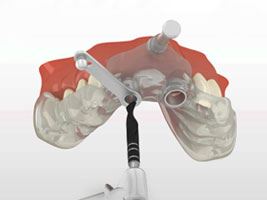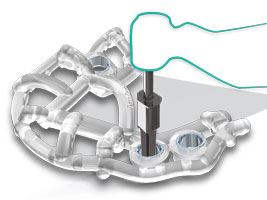No products
To be determined
Shipping
0,00€
Total
Product successfully added to your shopping cart
Quantity
Total
There are 0 items in your cart.
There is 1 item in your cart.
Total products
Total shipping
To be determined
Total
Surgical template for dental implants installation

Collaboration with orthopedic gives an opportunity to make a surgical template. It shows to the surgeon the position of the future prosthesis that helps to adjust the implant position.
Usually the template is made of self-hardening plastic; it is applied to a wax teeth model, or on an existing prosthesis. Its function is the definition of the optimal implants location. In some cases this effect reaches by the strict limitation of the place for the implant, in the other a template just restricts a prosthetic space that caters to the surgeon. Recently widespread computer simulation, t his made it possible to simulate the superstructure using 3D- technology in the same way can be modeled as a pattern. There are different methods of making a template but they are subject to a number of principles:
• Template must be tough;
• Possibility of sterilization;
• The shape and position of the teeth must be clearly defined;
• Stability in the mouth.
Surgical template design
Patterns help to determine the optimal position of implants. They can be of different lengths depending on the defect; by using some of them one can accurately determine the position, others define the contours of the future denture allowing several options to choose the position of the implant surgery. There are surgical and a restoration requirement for the template designing that influences the success of the treatment and always must be followed. First you need to determine if the prosthesis is fixed with screws or cement. If it is screw fixation, especially in the anterior area, it is necessary to make the holes for the screws on the oral side of the prosthesis. When using cement fixation on the longitudinal axis of the implant it must pass through the cutting edge or even a lip surface without sacrificing appearance.
Template, severely restricts the direction of movement drills

This design pattern has holes on the occlusal surface of simulated teeth, which determine the position of the implant asking direction drill in bone tissue. They also control the depth of the drill insertion and thus the depth of the implant screwing. The disadvantage of this type of template is the impossibility of deviation from the predetermined direction drills, if during the surgical stage the need arises, due to anatomical features, not found during the preliminary examination and radiography. For example it is very difficult to pass a drill palatal, but still with the capture of the occlusal template surface. The ability to use these patterns depends on the design of future denture.
 Patients with edentulous there is more freedom of manipulation than in patients with intact natural teeth. In those cases when stored natural teeth a template can be more precisely placed between adjacent teeth. Unfortunately, while using a template of the fully edentulous patients, no matter on the upper or lower jaw, is extremely difficult to remove reclined flap surgical field , if the pattern has a large size . Also it can be difficult to stabilize the pattern on the operative field. However, for the fully edentulous patients is better to choose a template with less restrictive design.
Patients with edentulous there is more freedom of manipulation than in patients with intact natural teeth. In those cases when stored natural teeth a template can be more precisely placed between adjacent teeth. Unfortunately, while using a template of the fully edentulous patients, no matter on the upper or lower jaw, is extremely difficult to remove reclined flap surgical field , if the pattern has a large size . Also it can be difficult to stabilize the pattern on the operative field. However, for the fully edentulous patients is better to choose a template with less restrictive design.

Template that allows the surgeon to choose the direction of the drill
This is a very popular template. It is a dental arch which kept only the vestibular surface and palatal cut. Thus, it will create the opportunity for the formation of the bone bed, and changes drill destinations during surgery so the longitudinal axis of the implant would not pass through the vestibular surface of the prosthesis. The same result can be obtained using the angular abutment, but its use is not always possible and may create difficulties in making a prosthesis. Some authors suggest the use of a rigid template with the contours of the sky but unfortunately, it leads to complications when the implant is more palatal in the complete absence of teeth.


